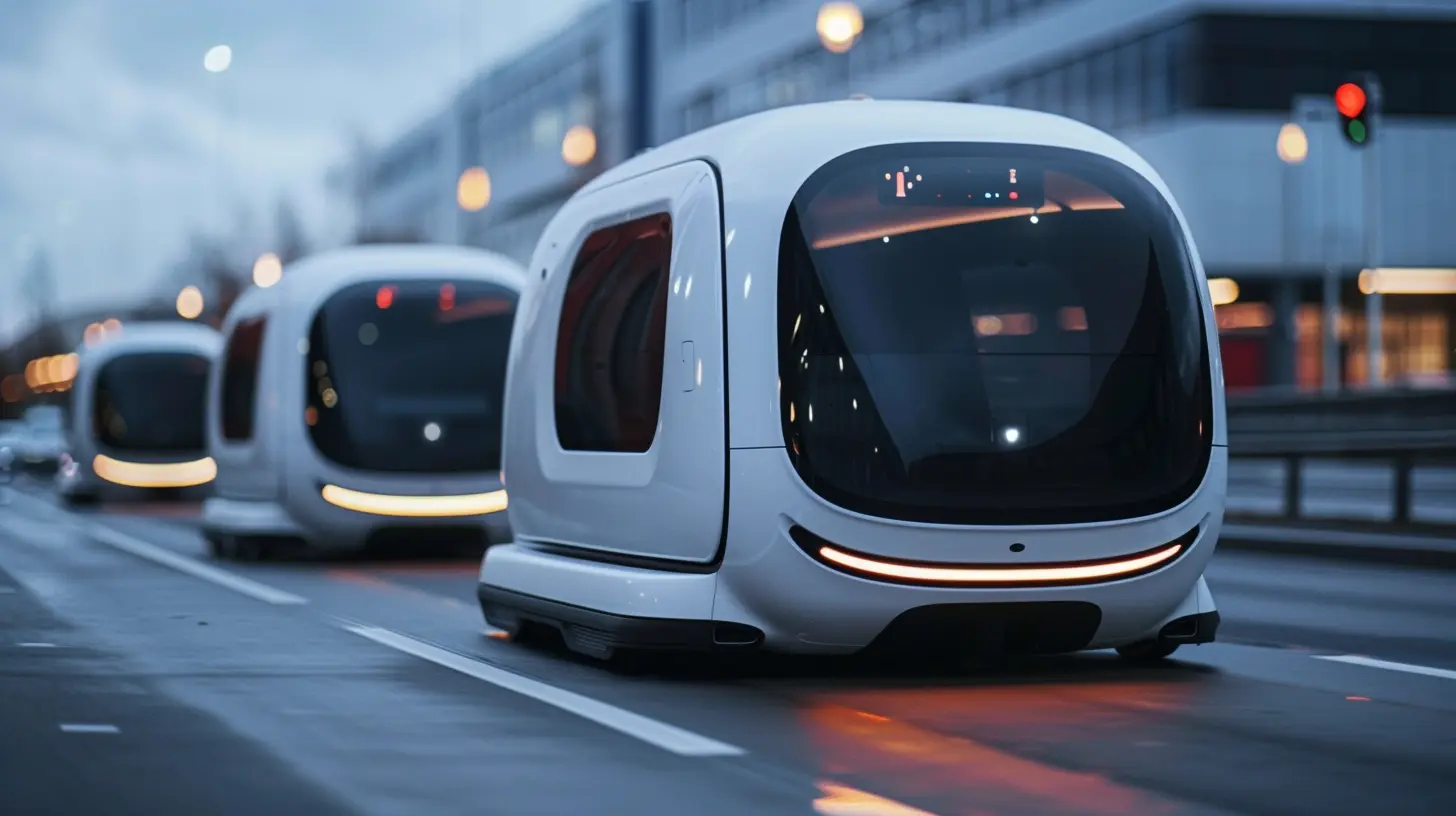The Complexities of Securing Autonomous Vehicles from Cyber Attacks
28 December 2024
Imagine a world where cars drive themselves. No traffic jams, no human error, just seamless transportation. It sounds like something straight out of a sci-fi movie, right? Well, autonomous vehicles (AVs) are no longer just a dream. Companies like Tesla, Waymo, and Uber are already deep into the development of these self-driving cars. But as awesome as this technology is, there's one huge hurdle standing in the way: cybersecurity.
With great technological advancements come even greater risks. Hackers aren’t just interested in your bank accounts or social media profiles anymore. They’re targeting cars—specifically, autonomous ones. And let’s be real here, the thought of some random cybercriminal remotely taking control of a car that’s driving itself? That’s the stuff of nightmares.
In this article, we’re diving deep into the complexities of securing autonomous vehicles from cyber attacks. We’ll break down the challenges, the potential threats, and what’s being done to keep these futuristic rides safe. Buckle up—it’s going to be a wild ride!

Why Are Autonomous Vehicles Vulnerable to Cyber Attacks?
Before we get into the nitty-gritty of cyber threats, let’s first understand why autonomous vehicles are so vulnerable in the first place.1. Massive Amounts of Data
Autonomous vehicles are like data sponges. They collect and process an insane amount of information every second. We're talking about GPS data, traffic patterns, weather conditions, and even pedestrian movements. All of this data is necessary to ensure the car can navigate safely on its own. But here’s the problem: the more data a system has, the more entry points it creates for hackers.2. Multiple Systems at Play
An autonomous vehicle isn’t just one system; it’s a symphony of interconnected systems working together in real-time. You’ve got sensors, cameras, radar, LiDAR, GPS, and a bunch of other tech all communicating with each other to make sure the car stays on the road. Each of these components is a potential weak point that a hacker could exploit. It’s like trying to guard a fortress with a thousand doors—tough, right?3. Internet Connectivity
Here’s where things get even more complicated. Autonomous vehicles rely heavily on internet connectivity to function. They need to communicate with other vehicles, infrastructure, and even cloud servers for software updates. While this connectivity is essential for AVs to work, it also opens the door for cybercriminals to sneak in. Once they’ve got access, they can wreak all sorts of havoc.4. Complex Software
The software running an autonomous vehicle is incredibly complex. It’s not like your typical smartphone app. We’re talking millions of lines of code. With this much complexity, there are bound to be vulnerabilities hidden somewhere. And if hackers find even the tiniest loophole, they can exploit it to compromise the entire vehicle.
The Types of Cyber Attacks Autonomous Vehicles Face
Now that we know why autonomous vehicles are vulnerable, let’s talk about the specific cyber threats they face. These aren’t your basic phishing scams or malware attacks. Nope, we’re dealing with some seriously sophisticated stuff here.1. Remote Hijacking
This is probably the scariest type of attack. Imagine driving down the highway in your autonomous vehicle, and suddenly, the car starts doing its own thing. It speeds up, swerves, and refuses to respond to your commands. That’s remote hijacking in a nutshell. Hackers can take control of the vehicle's systems remotely and manipulate everything from the steering to the braking system.2. Denial of Service (DoS) Attacks
We’ve all heard about DoS attacks in the context of websites, where hackers flood a server with traffic to make it crash. Well, the same thing can happen to an autonomous vehicle. If hackers overload the car’s systems with data requests, it could cause the vehicle to freeze or malfunction. In a worst-case scenario, this could lead to accidents.3. Data Theft
As we mentioned earlier, autonomous vehicles collect tons of data. Unfortunately, that data includes personal information like your home address, travel history, and even biometric data. If hackers get their hands on this information, they could use it for identity theft or sell it on the dark web.4. False Data Injection
Autonomous vehicles rely on accurate data to make decisions. If a hacker manages to inject false data into the vehicle’s system, they could trick the car into making dangerous decisions. For instance, the hacker could alter the car's GPS so it thinks it’s on a clear road when there’s actually a traffic jam or a pedestrian crossing.5. Ransomware Attacks
Just like with computers, ransomware can lock up an autonomous vehicle until the driver pays a ransom. Imagine being locked out of your own car, unable to start it or drive it, unless you fork over thousands of dollars in Bitcoin to a hacker. Yeah, not fun.
The Challenges of Securing Autonomous Vehicles
By now, you’re probably wondering, “Why don’t automakers just beef up security and call it a day?” Well, securing autonomous vehicles is easier said than done. Here are some of the biggest challenges they face:1. Balancing Security with Performance
There’s always a trade-off between security and performance. The more security features you add, the slower a system can become. Autonomous vehicles need to make split-second decisions, so any lag or delay could be catastrophic. Automakers have to strike a delicate balance between keeping the vehicle secure and ensuring it performs efficiently.2. The Complexity of the Supply Chain
Autonomous vehicles are made up of components from hundreds of different suppliers. Each supplier is responsible for securing their own piece of the puzzle. But all it takes is one weak link in the chain for the entire vehicle to be vulnerable. Ensuring that every supplier follows the highest security standards is a monumental task.3. Constant Software Updates
Like your smartphone or laptop, autonomous vehicles need regular software updates to stay secure. But pushing these updates to millions of vehicles worldwide is no small feat. Not only do automakers need to ensure the updates are secure, but they also need to ensure that hackers can’t intercept them or install malicious software in the process.4. Lack of Industry Standards
One of the biggest challenges is the lack of standardized security protocols across the industry. Different automakers have different approaches to cybersecurity, which creates inconsistencies. Until there’s a universal set of standards, it will be difficult to ensure that all autonomous vehicles are equally secure.
How Automakers and Tech Companies Are Tackling the Problem
Despite the challenges, automakers and tech companies aren’t sitting idly by. They’re actively working on solutions to secure autonomous vehicles from cyber attacks. Here’s what they’re doing:1. Encryption and Authentication
Encryption is one of the most basic forms of cybersecurity, but it’s incredibly effective. Automakers are using encryption to protect the data transmitted between the vehicle and external systems. They’re also implementing strong authentication protocols to ensure that only authorized users can access the vehicle’s systems.2. AI-Powered Threat Detection
Artificial intelligence (AI) is being used to detect and respond to cyber threats in real-time. By analyzing data patterns, AI can identify unusual activity that might indicate a cyber attack. Once a threat is detected, the system can take immediate action to prevent the attack from causing any damage.3. Blockchain Technology
Blockchain isn’t just for cryptocurrencies anymore. Some automakers are exploring the use of blockchain technology to create a decentralized, tamper-proof ledger of all the vehicle’s data. This would make it much harder for hackers to alter or manipulate the vehicle’s systems.4. Collaboration Between Automakers and Cybersecurity Firms
Automakers are starting to realize that they can’t tackle this problem alone. Many are partnering with cybersecurity firms to develop advanced security solutions. By pooling their resources and expertise, they’re better equipped to fend off cyber threats.5. Government Regulations
Governments are also stepping in to help. In some countries, new regulations are being introduced that require automakers to meet certain cybersecurity standards. While these regulations are still in the early stages, they could play a crucial role in making autonomous vehicles safer.The Future of Securing Autonomous Vehicles
So, what does the future hold for cybersecurity in autonomous vehicles? Well, it’s clear that there’s still a long road ahead. Autonomous vehicles are only going to become more prevalent, and as they do, the cyber threats will only become more sophisticated. But with continued advancements in AI, encryption, and industry collaboration, we’re moving in the right direction.One thing’s for sure: cybersecurity will play a pivotal role in the success of autonomous vehicles. Without robust security measures in place, the risks will simply be too great for widespread adoption. But if automakers can rise to the challenge, the future of transportation could be safer, more efficient, and more exciting than ever before.
Conclusion
Securing autonomous vehicles from cyber attacks is no easy task. These vehicles are vulnerable because of the sheer amount of data they process, the complexity of their systems, and their reliance on internet connectivity. The types of cyber attacks they face range from remote hijacking to data theft and ransomware. While there are many challenges to overcome, automakers and tech companies are making significant strides in protecting these vehicles from cyber threats.As autonomous vehicles continue to evolve, so too will the methods used to secure them. It’s a complex issue, but one that will ultimately determine the future of our roads. So, next time you see a self-driving car zipping down the highway, remember: there’s a lot more going on under the hood than meets the eye.
all images in this post were generated using AI tools
Category:
Cyber ThreatsAuthor:

Kira Sanders
Discussion
rate this article
18 comments
Thor McNeil
Security: The road less traveled.
March 24, 2025 at 1:10 PM

Kira Sanders
Thank you for your insight! Indeed, navigating security for autonomous vehicles is uncharted territory, but it's crucial to ensure safe and reliable technology.
Clara McClellan
Securing autonomous vehicles from cyber attacks is multifaceted, requiring robust encryption, continuous software updates, and collaboration among manufacturers, regulators, and cybersecurity experts to mitigate risks and protect user safety.
February 13, 2025 at 8:15 PM

Kira Sanders
Absolutely, your insights highlight the critical need for a comprehensive approach to cybersecurity in autonomous vehicles, emphasizing collaboration and continuous innovation to ensure user safety.
Lysander McEachern
Securing autonomous vehicles is not just a challenge; it's an opportunity to redefine safety and innovation in transportation. Let's drive forward together!
February 3, 2025 at 7:33 PM

Kira Sanders
Absolutely! Embracing these challenges can lead to groundbreaking advancements in safety and technology for the future of transportation. Let's innovate together!
Ariana McCoy
Great insights on a critical topic! As autonomous vehicles evolve, prioritizing cybersecurity is essential for public trust and safety. Collaborative efforts among tech companies, policymakers, and researchers will be key to overcoming these challenges. Keep up the important work!
January 31, 2025 at 5:03 AM

Kira Sanders
Thank you for your thoughtful comment! I completely agree—collaboration among stakeholders is vital for ensuring the safety and security of autonomous vehicles.
Aisha McKeever
Securing autonomous vehicles is crucial; vulnerabilities can have serious safety and operational implications.
January 27, 2025 at 12:20 PM

Kira Sanders
Absolutely, securing autonomous vehicles is essential to ensure safety and maintain trust in this technology. Vulnerabilities can indeed lead to significant risks. Thank you for your insights!
Wolf McMichael
Securing autonomous vehicles requires a multi-layered approach, blending technology, regulations, and constant vigilance against evolving threats.
January 19, 2025 at 8:51 PM

Kira Sanders
Absolutely, a multi-layered strategy is essential for addressing the diverse threats facing autonomous vehicles, combining technological solutions, regulatory frameworks, and ongoing vigilance. Thank you for your insightful comment!
Daphne Strickland
Imagine a world where your car not only drives itself but also moonlights as a cyber ninja, defending against hackers with its advanced algorithms! If only we could teach it to dodge potholes as expertly as it dodges cyber threats!
January 12, 2025 at 6:09 AM

Kira Sanders
That's a fun vision! As we advance in autonomous technology, balancing physical safety and cybersecurity will be crucial. Who knows what innovations the future holds!
Rusty Sawyer
While we’re busy teaching cars to drive themselves, let's not forget they also need a digital bodyguard! Securing autonomous vehicles from cyber threats is like giving them a virtual seatbelt—absolutely essential for a safe ride into the future! Buckle up!
January 8, 2025 at 4:37 AM

Kira Sanders
Absolutely! Just like traditional safety measures, cybersecurity is vital for the safe deployment of autonomous vehicles. A digital bodyguard is essential for protecting both passengers and data. Buckle up indeed!
Erica Murphy
Great insights! As we move closer to fully autonomous vehicles, understanding the cybersecurity challenges is crucial. Excited to see how evolving tech will bolster defenses and ensure safe, secure journeys for everyone. Keep up the fantastic work!
January 7, 2025 at 11:25 AM

Kira Sanders
Thank you for your thoughtful comment! I completely agree that addressing cybersecurity challenges is vital for the future of autonomous vehicles. Excited for the advancements ahead!
Mary McCallum
Securing self-driving cars is like giving a raccoon keys; you never know what chaos will ensue!
January 5, 2025 at 8:16 PM

Kira Sanders
While the comparison highlights the unpredictability of technology, securing self-driving cars is crucial to ensuring their safe and reliable operation in our increasingly automated world.
Vesper McFarlin
Thank you for shedding light on this critical issue. As autonomous vehicles become more prevalent, addressing cybersecurity is vital for public safety and trust. I appreciate your insights into the complexities involved and look forward to future advancements in this field.
January 3, 2025 at 1:17 PM

Kira Sanders
Thank you for your thoughtful comment! I'm glad you found the insights valuable as we navigate the important intersection of cybersecurity and autonomous vehicles.
Winona Mendez
Securing autonomous vehicles isn’t just a challenge; it’s a non-negotiable imperative. Cyber threats are evolving—so must our defenses. We can't afford complacency in this critical frontier.
January 3, 2025 at 5:38 AM

Kira Sanders
Absolutely agree! The rapidly evolving cyber threats demand continuous innovation in our security measures for autonomous vehicles to ensure safety and trust in this transformative technology.
Pilar Johnson
Great insights! It's crucial to address the cybersecurity challenges of autonomous vehicles as they become more prevalent. Excited to see the innovations ahead!
January 2, 2025 at 9:46 PM

Kira Sanders
Thank you! I completely agree—securing autonomous vehicles is vital as they evolve. Exciting innovations are on the horizon!
Tabitha Kane
This article highlights a crucial issue in our rapidly evolving tech landscape. Protecting autonomous vehicles from cyber threats is essential for safety and public trust. It's a complex challenge that requires our collective attention and innovation.
January 2, 2025 at 3:40 AM

Kira Sanders
Thank you for your insightful comment! I completely agree that securing autonomous vehicles is vital for ensuring safety and building public trust, and it indeed calls for collaborative innovation.
Daniella Alexander
Securing autonomous vehicles from cyber attacks is like teaching a cat to fetch—complex, unpredictable, and likely to result in a few hair-raising moments along the way!
December 30, 2024 at 5:31 AM

Kira Sanders
Thank you for the clever analogy! Securing autonomous vehicles is indeed a challenging task that requires innovative solutions and constant vigilance.
Clarissa Luna
This article highlights the crucial need for robust cybersecurity measures in autonomous vehicles, balancing innovation with safety and public trust.
December 29, 2024 at 12:04 PM

Kira Sanders
Thank you for highlighting the importance of cybersecurity in autonomous vehicles. Balancing innovation with safety is indeed vital for fostering public trust.
Winona McKinley
This article effectively highlights the intricate challenges of securing autonomous vehicles against cyber threats. While progress is being made, the need for robust security measures and ongoing research cannot be overstated.
December 29, 2024 at 4:14 AM

Kira Sanders
Thank you for your insightful comment! I completely agree that robust security measures and continuous research are vital in addressing the complexities of securing autonomous vehicles against cyber threats.
Zeno Hudson
This article highlights crucial challenges in securing autonomous vehicles from cyber threats. It's essential to prioritize safety and protect both technology and users. Navigating these complexities requires collaboration and innovation from all sectors to ensure a safer future for everyone.
December 28, 2024 at 1:37 PM

Kira Sanders
Thank you for your insightful comment! I completely agree that collaboration and innovation are vital for enhancing the safety and security of autonomous vehicles.
MORE POSTS

The Anatomy of a Perfect Touchscreen Display

How AI is Revolutionizing the Healthcare Industry

Photography Essentials: Reviewing the Best Mirrorless Cameras

How to Build a Portable LAN Party PC Gaming Rig
Wearable Tech for Women: Fitness Trackers That Focus on Female Health

The Future of PC Gaming: AI and Machine Learning in Games

The Role of Serverless Computing in Mobile App Development

Gadget Lovers Rejoice: Reviewing the Best Multi-Device Chargers

Autonomous Vehicles and the Race for Zero Emissions

Cybersecurity for Gamers: Keeping Your Accounts Safe

How to Optimize Your Mobile Device for Maximum Productivity